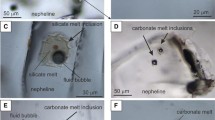Abstract
Structural and crystal-chemical observations on acicular and skeletal silicate-carbonate-hydroxyapatite crystals (SCHap) from comb-layer alvikite dykes of the Kaiserstuhl carbonatite complex yield strong evidence for their being quenched products. As well as being intimately intergrown with calcite, they also contain distinctive primary phosphate inclusions. In contrast to the host apatite, these inclusions are free of Si, low in LREE but enriched in Sr and the volatiles F and S, and contain a high concentration of Na. This pronounced fractionation combined with the absence of x-ray diffraction and electron diffraction patterns suggests that the phosphate inclusions represent portions of a trapped residual phosphate melt. Therefore the SCHap are considered to be the direct liquidus phase of a carbonate-phosphate melt. That two phosphate phases coexist, however, presumes strong enrichment of phosphorous in the parental carbonatitic melt, since the eutectic would otherwise produce calcite and apatite only. The formation of sharply interfaced apatite- and calcite-comb-layers and the occurrence of trapped phosphate melt inclusions in the quench apatites argue for the existence of two immiscible liquids such as a phosphate-rich and a carbonate-rich melt.
Similar content being viewed by others
References
Argiolas R (1978) Morphologie des cristaux d'apatite: influence des conditions experimentales et implication sur la petrogenese. These de doctorat 3eme cycle, Nice
Biggar, GM (1966) Experimental studies of apatite crystallization in parts of the system CaO-P205-H2O at 1,000 bars. Mineral Mag 35:1110–1122
Biggar GM (1967) Apatite compositions and liquidus phase relationships on the join Ca(OH)2-CaF2-Ca3(PO4)2-H2O from 250 to 4,000 bars. Mineral Mag 36:539–564
Biggar GM (1969) Phase relationships in the join Ca(OH)2-CaCO3-Ca3(PO4)2-H2O at 1,000 bars. Mineral Mag 37:75–82
Dawson JB, Hawthorne JB (1973) Magmatic sedimentation and carbonatitic differentiation in kimberlite sills at Benfontein, South Africa. J Geol Soc, London 129:61–85
Donaldson CH (1977) Laboratory duplication of comb layering in the Rhum pluton. Mineral Mag 41:323–336
Eysel W, Roy DM (1973) Hydrothermal flux growth of hydroxyapatites by temperature oscillation. J Crystal Groth 20:245–250
Green TH, Watson EB (1982) Crystallization of apatite in natural magmas under high pressure, hydrous conditions, with particular reference to ‘orogenic’ rock series. Contrib Mineral Petrol 79:96–105
Katz K, Keller J (1981) Comb-layering in carbonatite dykes. Nature 294:350–252
Katz-Lehnert K, Sommerauer J (in prep.) The crystal chemistry of apatite and its relation to the carbonatite rock evolution in the Kaiserstuhl alkaline complex (SW-Germany)
Le Bas MJ, Aspden J, Wooley AB (1977) Contrasting sodic and potassic glassy inclusions in apatite crystals from an ijolite. J Petrol 18:247–262
Moore JG, Lockwood JP (1973) Origin of Comb Layering and Orbicular Structure, Sierra Nevada Batholith, California. Geol Soc Am Bull 84:1–20
Romanchev BP (1972) Inclusion thermometry and the formation conditions of some carbonatite complexes in East Africa. Geochem Intern 9:115–120
Ryerson FJ, Hess PC (1980) The role of P2O5 in silicate melts. Geochim Cosmochim Acta 44:611–624
Sommerauer J, Katz-Lehnert K (1985) A new partial substitution mechanism of CO3/CO3OH and SiO4 for the PO4 group in hydroxyapatite from the Kaiserstuhl alkaline complex (SW-Germany) Contrib Mineral Petrol
Walther J (1981) Fluide Einschlüße im Apatit des Karbonatits vom Kaiserstuhl. Ein Beitrag zur Interpretation der Karbonatitgenese. Dissertation Universität Karlsruhe
Watson EB (1979) Apatite saturation in basic to intermediate magmas. Geophys Res Lett 6:937–940
Watson EB (1980) Apatite and phosphorous in mantle source regions: An experimental study of apatite/melt equilibria at pressures to 25 kbar. Earth Planet Sci Lett 51:322–335
Watson EB, Capobianco CJ (1981) Phosphorus and the rare earth elements in felsic magmas: an assessment of the role of apatite. Geochim Cosmochim Acta 45:2349–2358
Wyllie PJ (1967) Phase Equilibria in System CaO-CO2-H2O and Related Systems, with implications for Crystal Growth of Calcite and Apatite. J Am Ceram Soc 50:43–46
Wyllie PJ, Cox K, Biggar GM (1962) The habit of apatite in synthetic systems and igenous rocks. J Petrol 3:238–243
Author information
Authors and Affiliations
Rights and permissions
About this article
Cite this article
Sommerauer, J., Katz-Lehnert, K. Trapped phosphate melt inclusions in silicate-carbonate-hydroxyapatite from comb-layer alvikites from the Kaiserstuhl carhonatite complex (SW-Germany). Contr. Mineral. and Petrol. 91, 354–359 (1985). https://doi.org/10.1007/BF00374691
Received:
Accepted:
Issue Date:
DOI: https://doi.org/10.1007/BF00374691



